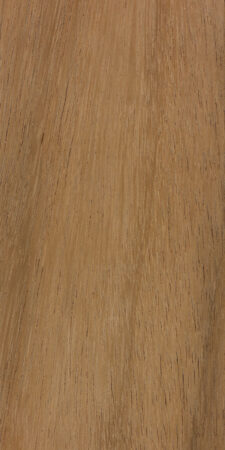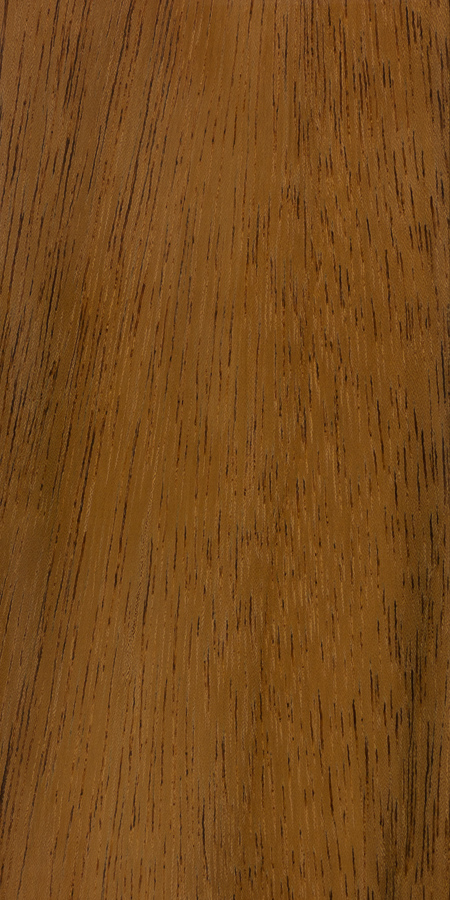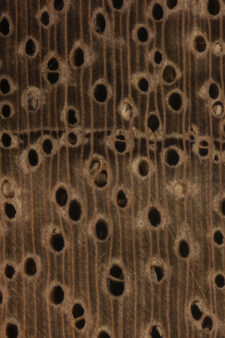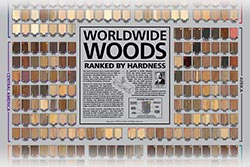Common Name(s): Dahoma, dabema
Scientific Name: Piptadeniastrum africanum (syn. Piptadenia africana)
Distribution: West, Central, and East Africa
Tree Size: 100-165 ft (30-50 m) tall,
3-6 ft (1-1.8 m) trunk diameter
Average Dried Weight: 43.4 lbs/ft3 (695 kg/m3)
Specific Gravity (Basic, 12% MC): .58, .70
Janka Hardness: 1,520 lbf (6,740 N)
Modulus of Rupture: 16,180 lbf/in2 (111.6 MPa)
Elastic Modulus: 1,871,000 lbf/in2 (12.9 GPa)
Crushing Strength: 8,430 lbf/in2 (58.2 MPa)
Shrinkage: Radial: 3.9%, Tangential: 8.7%,
Volumetric: 12.5%, T/R Ratio: 2.2
Color/Appearance: Heartwood is light yellowish or reddish brown. Contrasting sapwood may be up to six inches (15 cm) wide and is light gray to pale yellow. Quartersawn surfaces display a ribbon-stripe figure.
Grain/Texture: Grain is typically interlocked. With a uniform coarse texture and moderate natural luster.
Rot Resistance: Rated as moderately durable, with moderate/mixed resistance to termites and borers.
Workability: Easy to work with both hand and machine tools, though the wood has a tendency to blunt cutting edges. Tearout may occur when machining quartersawn pieces due to its interlocked grain. Dahoma will also react when put into direct contact with iron in damp conditions, becoming discolored and stained. Turns, glues, and finishes well.
Odor: Has an unpleasant, ammonia-like odor when freshly cut. Dry wood is odorless, though re-wetting the wood may bring out the odor again.
Allergies/Toxicity: Although severe reactions are quite uncommon, dahoma has been reported as a sensitizer. Can cause eye, skin, and throat irritation. See the articles Wood Allergies and Toxicity and Wood Dust Safety for more information.
Pricing/Availability: Seldom if ever available in North America, dahoma is more commonly exported to Europe, though not extensively so. Expect prices to be moderate when compared to other imported lumber.
Sustainability: This wood species is not listed in the CITES Appendices, and is reported by the IUCN as being a species of least concern.
Common Uses: Heavy construction, boatbuilding, docks, flooring, furniture, cabinetry, and turned objects. .
Comments: Usage between the two common names (dahoma and dabema) is split about 50/50 in English speaking countries. It’s sometimes also referred to as African greenheart, not to be confused with the much more common South American species, greenheart (Chlorocardium rodiei).
The IUCN reports that the species is a common tree and is widespread throughout tropical Africa. The wood is sometimes exported to Europe as a substitute for oak. Those seeking to use the wood for interior household applications should keep in mind that the wood can have an unpleasant odor, and the odor can easily be reactivated if the raw wood is ever moistened or otherwise exposed to water. Barring this caveat, dahoma appears to be an under-utilized and under-appreciated hardwood that bears a superficial resemblance to mahogany.
Images: Drag the slider up/down to toggle between raw and finished wood.
Identification: See the article on Hardwood Anatomy for definitions of endgrain features.
Porosity: diffuse porous
Arrangement: exclusively solitary and radial multiples
Vessels: large to very large, few to very few; light-colored deposits occasionally present
Parenchyma: vasicentric, lozenge, confluent, and sometimes banded (marginal)
Rays: medium to wide width (though just barely visible without magnification), normal to wide spacing
Lookalikes/Substitutes: Superficially, the grain can sometimes resemble various types of mahogany. However, in addition to lacking dahoma’s fluorescence response under a blacklight, true mahogany (Swietenia genus) and the close substitutes from Africa (Khaya genus) tend to have much more limited amounts of parenchyma surrounding the pores (only vasicentric), while dahoma tends to have parenchyma that can also be lozenge and confluent. Okan (Cylicodiscus gabunensis) is another African hardwood with similar appearance and very similar anatomy—both are sometimes sold under the name African greenheart. Okan tends to have darker, more colorful heartwood and is approximately 30% heavier than dahoma.
Notes: Heartwood fluoresces a medium to bright yellowish green when viewed under a blacklight.
None available.
Related Content:













Unpleasant doesn’t begin to describe the odor. Genuinely the worst smelling wood I’ve ever had the misfortune of using. Avoid this for anything indoors, spare yourself.